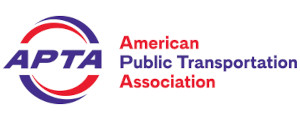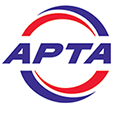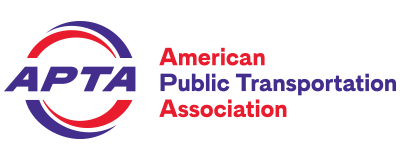Introduction
Chairman Rouzer, Ranking Member Norton, and Members of the Subcommittee on Highways and Transit of the Committee on Transportation and Infrastructure, on behalf of the American Public Transportation Association (APTA) and its more than 1,600 public- and private-sector member organizations, thank you for the opportunity to testify for this very important hearing.
My name is Nat Ford, and I am a former Chair of APTA, an international association representing the $79 billion public transportation industry that directly employs more than 430,000 people and supports millions of private-sector jobs.1
I also serve as CEO of the Jacksonville Transportation Authority (JTA), a multi-modal agency that operates public transportation in Duval County and neighboring counties. We also have the duties and responsibilities of an expressway authority, carrying out major highway, bridgework and roadways infrastructure projects. With each project and service, the JTA is one step closer in achieving its mission to enhance Northeast Florida’s economy, environment, and quality of life through mobility solutions.
We began JTA’s MobilityWorks program in 2015 which included 27 complete streets, transit enhancement projects and upgrades to the ferry at a cost totaling $200 million. It was completed two years ahead of schedule. This success led the way for an extension of a local option gas tax, which will generate an additional $500 million in capital projects, with the creation of more jobs and positive economic impact.
As a multi-modal agency, mobility innovation is key to ensuring reliable and safe services to all our customers. We provide fixed route; First Coast Flyer, which is our bus rapid transit (BRT) service; paratransit with Connexion and Connexion Plus; mobility on demand services, such as Go Tuk-In, Beachside Buggies, and ReadiRide zones; and regional services to three neighboring counties. In addition, JTA operates transit services in both Clay and Nassau Counties, as well as the St. Johns River Ferry. We also operate the Skyway, an automated elevated people mover that we are transforming into a shared autonomous vehicle network called the Ultimate Urban Circulator.
On behalf of APTA, I would like to share with the Subcommittee some of the issues that are critical to our industry and discuss some of the innovations and unprecedented approaches that public transit agencies are advancing every day to deliver better, safer, and more cost-effective mobility services for Americans. As always, we offer any assistance we can provide as an association to help Congress pass a surface transportation authorization bill that invests in American jobs and supports support the millions of people who rely on public transportation and its significant economic benefits each day.
Investment in public transportation helps communities of all sizes flourish—connecting workers to jobs, students to school, and people to healthcare. Private-sector businesses depend on Federal transit funding to create jobs in communities across the country, consistent with Buy America laws. In fact, 77 percent of Federal public transit investment flows to the private sector, and public transportation manufacturing relies on more than 2,000 suppliers in 48 States and Washington, DC.
Americans continue to demonstrate the need for public transportation. Our industry has seen ridership steadily increase after falling to 20 percent of 2019 levels in April 2020. Since then, public transit ridership has reached more than 80 percent of 2019 levels, and it continues to grow. For instance, in 2023, ridership increased 16 percent. In 2024, ridership increased by more than 490 million trips, or 7 percent. A growing number of systems have fully recovered and have exceeded 2019 levels. These facts demonstrate the tremendous resiliency of this industry.
And it is important to recognize the enormous scale of our nation’s public transit ridership. Transit riders took 7.7 billion trips in 2024—an average of 25 million trips each day. Beyond ridership numbers and percentages, it is critically important to recognize why people take public transit—it creates opportunities. For millions upon millions of Americans, accessible, affordable public transportation helps families, students, and workers save money and grow the economy. According to a recent APTA study, people can save more than $13,000 each year by using public transit instead of driving.
Building for the Future
APTA is sincerely thankful for the historic investments in public transportation in the Infrastructure Investment and Jobs Act (P.L. 117-58) (IIJA). The IIJA provides $108.2 billion for public transit over five years (FY 2022 through FY 2026).
By using IIJA transit and rail funding as a baseline to build from, recognizing increased costs due to inflation, and adopting commonsense streamlining reforms, Congress can ensure that the next surface transportation authorization bill will help address the state-of-good-repair backlog, encourage continued ridership growth, have a greater economic impact for communities, and provide a greater value for taxpayers.
Transit agencies across the country are working toward a state of good repair, providing economic opportunities to their communities and driving innovation. For example:
- The Northern Indiana Commuter Transportation District added 26 miles to double track its South Shore Line. It eliminates 13 grade crossings, adds 14 new weekday trains, and cuts the travel to Chicago by 30 minutes. The project, awarded a construction grant agreement in 2021, was completed on time and under budget.
- Valley Metro also completed its 2021 Northwest Extension Phase II light rail project ahead of schedule and under budget. The project connects the West Valley to downtown Phoenix and neighboring communities and is already averaging 50,000 riders per month since opening in January 2024. Phoenix is now working on redeveloping its new terminus—a former mall—into multi-family housing, hotels, restaurants, and new retail space. Phoenix will soon complete its South Central Extension/Downtown Hub corridor to connect the current light rail system in downtown Phoenix with other culturally significant neighborhoods.
- Skagit Transit, in a small Washington State community, is moving its operations facility, currently located in a 100-year floodplain, to a new facility with clean energy infrastructure that will enable a transition to a zero-emission fleet. In addition, the facility will help Skagit Transit, as a partner in county emergency preparedness operations, support community resiliency during emergency events.
- The Metro Gold Line in the Minnesota Twin Cities region recently opened on time and under budget, the first of three Twin City bus rapid transit (BRT) lines that will open in 2025. The 10-mile bus rapid transit line connects people to job centers and other destinations in St. Paul, Maplewood, Landfall, Oakdale, and Woodbury with frequent, all-day service.
APTA urges Congress to build upon the successful investments of the IIJA. To make Federal dollars go further (as described in more detail below) APTA recommends that Congress:
- Conduct a zero-based review of Capital Investment Grants (CIG) program requirements to eliminate any requirements that do not meet a two-part test: to build good CIG projects that protect the taxpayer interest.
- Provide flexibility for public transit agencies to acquire land prior to National Environmental Policy Act (NEPA) review completion, on parity with highway projects.
- Help address transit workforce needs by eliminating the Federal Motor Carrier Safety Administration’s (FMCSA) Commercial Driver’s License (CDL) under-the-hood testing for bus operators.
- Improve drug testing processes and results by urging the Department of Health and Human Services (HHS) to certify laboratories needed to conduct oral fluid drug testing.
Investing in Public Transportation Yields Great Benefits
Creating Jobs, Growing the Economy, and Providing Opportunities
Public transportation represents a $79 billion industry that directly employs more than 430,000 people and supports millions of private-sector jobs. 77 percent of Federal public transit investment flows to the private sector through spending on capital projects, contracted and other services, fuel, materials, and supplies.
For every $1 billion invested in public transportation, nearly 50,000 jobs are created or sustained across the entire economy, including in non-transit industries.2 For every $1 invested in public transportation, approximately $5 in long-term economic return is generated.3 Investment in public transportation creates jobs in communities of all sizes throughout the country, including in smaller urban and rural areas where buses, railcars, and their parts are often manufactured.
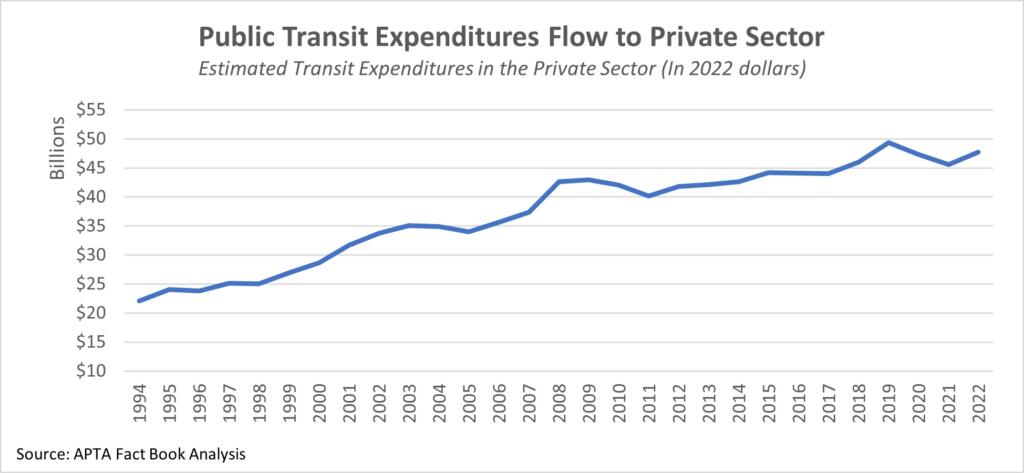
In addition, the public transportation industry provides investment opportunities across the country, ranging from manufacturing to design and construction, to operations and maintenance, to data management and technological innovation. And public transportation agencies rely on their private-sector partners to help deliver innovative transit projects efficiently.
For instance, a Capital Investment Grant (CIG) project in California may include thousands of construction jobs onsite, but its rolling stock, parts, or materials may come from manufacturers and suppliers in Alabama, Georgia, Kansas, or Pennsylvania.
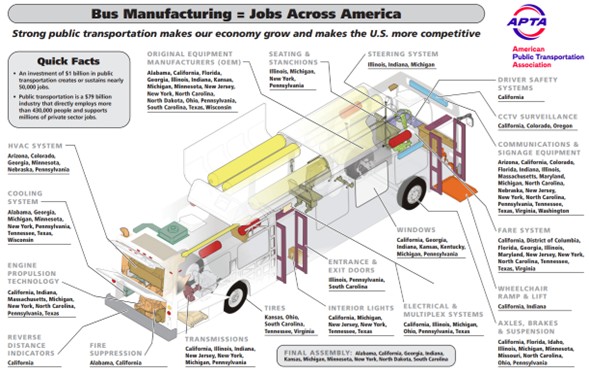
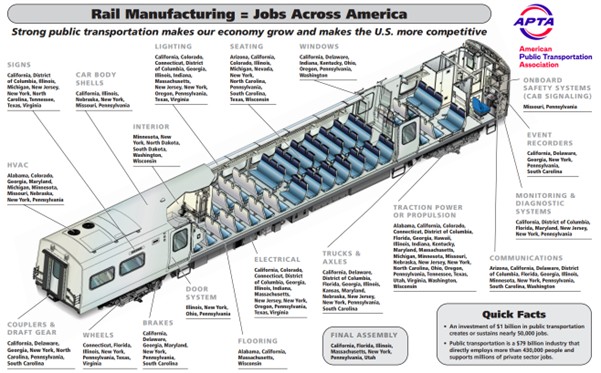
Moreover, after a new transit line is constructed and operational, there are ongoing, permanent economic growth and development impacts enabled by the transportation improvements and associated economic productivity gains.
Addressing State-of-Good-Repair Needs
With a Department of Transportation (DOT) estimated state-of-good-repair backlog of more than $101 billion, support from all levels of government is sorely needed. The recent American Society of Civil Engineers (ASCE) Report Card echoes DOT’s findings. ASCE gives public transit a grade of “D”, a slight improvement from the last report card in 2021. Moreover, ASCE identifies a $152 billion funding gap for public transit over the next 10 years.
Today, most agencies operate buses and railcars beyond their useful lives. Of the 119,000 transit buses and vans, almost one in six are not in a state of good repair.4 For rail transit vehicles, the average fleet age is 24 years. Agencies are using the investments of the current authorization law to bring their rolling stock, guideway elements, systems, stations, and facilities to a state of good repair.5
Traveling Safely to Your Destination
For the public transportation industry, safety is a core value—a non-negotiable operating principle and promise to our riders and workers. The men and women responsible for managing and operating public transportation systems are fully committed to the safety of their passengers, employees, systems, and the public. As a result, traveling by public transportation is 10 times safer for passengers than traveling by car, and modest increases in transit ridership can cut traffic fatalities by 50 percent.6
Rider-focused investments to improve service, safety, and accessibility are why ridership is increasing across the country. To address transit safety concerns, many agencies are adopting a layered approach, increasing the number of law enforcement personnel and supporting them with “transit ambassadors”, mental health professionals, and public awareness campaigns.
In Jacksonville, Federal and local policies supporting DOT’s Vision Zero initiatives align with investments in public transportation to create safer, more accessible communities. JTA is developing a transit-centered approach to Vision Zero through its Creating Safe Spaces Action Plan (CSSAP), which focuses on pedestrian and bicyclist safety around public transit assets. In addition, smart traffic signals, connected vehicle technology, and AI-based safety monitoring can reduce accidents and enhance transit reliability.
Driving Innovation
Public transit is at the forefront of innovation. From hybrid buses to light rail systems, public transportation agencies are leveraging new technologies to promote clean energy, electric vehicle deployment, and fuel efficiency. Currently, 55 percent of transit buses use alternative fuels, with 20 percent of all buses utilizing hybrid-electric technology, compared to only three percent of U.S. cars and Sport Utility Vehicles. Communities that invest in public transit reduce the nation’s carbon emissions by 63 million metric tons annually. Overall, public transportation saves the U.S. six billion gallons of gasoline each year. The public transit industry will continue to lead the way in adopting new technologies.
In addition, public transit agencies are harnessing new technologies to better serve our customers. Well-planned public transportation reduces congestion, improves accessibility, and encourages private-sector investment in infrastructure. Enhancing transportation networks can revitalize downtowns and commercial corridors, supporting small businesses and increasing local tax revenues. Smart city technologies, such as AI-powered traffic management and digital fare integration, can improve transit efficiency and user experience.
In Jacksonville, we are moving forward with a transformative project we call the Ultimate Urban Circulator (U²C). U²C is a comprehensive program to modernize the existing Skyway and expand downtown Jacksonville’s public transportation service by introducing shared autonomous vehicles into the system. The U²C will provide greater connectivity and mobility by expanding the reach of the Skyway to at-grade roadways.
We are completing an unfinished story when we convert, modernize, and repurpose existing infrastructure with the Skyway Conversion. The U²C program will deliver an estimated 10-mile autonomous transportation network into adjacent neighborhoods in a cost-effective method that leverages existing infrastructure with agnostic and evolving system upgrades.
The first phase of the U²C, known as the Bay Street Innovation Corridor, was spearheaded by a Better Utilizing Investments to Leverage Development (BUILD) grant from the U.S. Department of Transportation, awarded in 2018. This same program awarded two other autonomous vehicles projects that year in other parts of the United States.
Thanks to this Federal investment, investment from the Florida Department of Transportation, and local funding, the JTA will deploy the first autonomous vehicle network for public transportation in June 2025.
The benefits have exceeded our expectations, with the U²C attracting national and international attention that led to HOLON, a subsidiary of the BENTELER Group, to select Jacksonville to establish its first U.S. production facility for shared autonomous vehicles. This project marks Florida’s first automotive vehicle manufacturing operation and represents a significant economic opportunity for Jacksonville and Northeast Florida. Key sectors benefiting from these impacts include manufacturing, real estate, healthcare, and professional services.
We believe that transportation is the great equalizer. JTA will continue to adopt innovative technologies, and shared autonomous shuttles will provide agile, nimble, reliant, and safe transportation throughout our system.
Providing Rural Access
Today, approximately 6,800 organizations provide public transportation, and the majority of agencies serve rural areas. According to Federal Transit Administration (FTA) data, 1,253 transit agencies operate in rural areas and 941 transit agencies operate in urbanized areas (i.e., areas with a population of 50,000 or more). In addition, there are approximately 4,580 nonprofit public transportation providers operating across the nation.
In rural areas, especially for seniors and people with disabilities, public transportation is a lifeline. Rural residents with disabilities rely heavily on public transit, taking approximately 50 percent more public transit trips than those without disabilities.7 Ridership in rural areas is estimated to be 135 million annual trips. Public transit is critical for connecting users to needed services, including access to medical care for the almost five million U.S. veterans living in rural areas and for providing Medicaid recipients with non-emergency medical transportation (NEMT) services to mental health, substance abuse, chemotherapy, dialysis, and other critical chronic and preventive care appointments.
Providing More Mobility Choices
Public transit investment also helps communities begin to address the demand for more mobility choices. CIG funding provides critical investments for new and expanded subways, light rail, commuter rail, streetcars, and bus rapid transit (BRT), among others. Over the past 15 years, 28 States have received CIG construction grant agreements or are in the current pipeline. Projects include BRT projects in Minnesota, Nevada, and Pennsylvania; commuter rail projects in Texas and Indiana; and heavy and light rail projects in Arizona, California, New York, and Utah. Public transportation projects that are funded through the CIG program are an essential component of addressing the mobility demands of growing communities.
Today, 61 projects across the nation are seeking $35 billion of CIG funding in FY 2026 and subsequent years.8
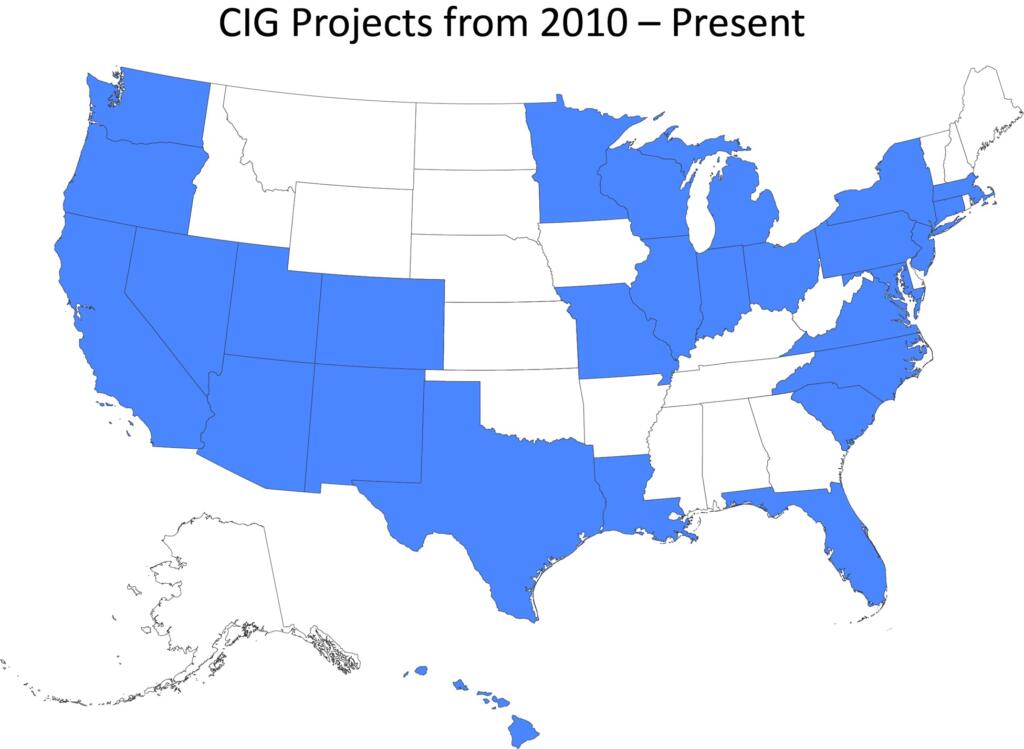
APTA Regulatory Reform Proposals
APTA is committed to working with Congress to advance critical public transportation funding and policy provisions in the next Surface Transportation Authorization bill. We are engaging our members to develop a comprehensive proposal and have already adopted several policies that would help advance projects in a timelier and more cost-effective way. For instance, enclosed are several regulatory proposals that APTA has adopted and that we will be submitting to the Committee for its consideration. We stand ready to help to advance these policies in the next authorization bill.
Zero-based Review of CIG Program
Beginning with enactment of the Transportation Equity Act for the 21st Century (TEA 21) (P.L. 105-178) in 1998, both Congress and FTA have repeatedly layered additional requirements on the CIG program, resulting in a less than clear process. APTA urges both Congress and FTA to adopt CIG reforms to strengthen the CIG program, expedite approval, and ensure that beneficial projects across the nation are delivered in a timely manner. We urge Congress to undertake a zero-based review of all CIG statutory requirements in the next authorization bill to eliminate any requirements that do not meet a two-part test: to build good CIG projects that protect the taxpayer interest.
In addition, project sponsors applying for both CIG funding and Transportation Infrastructure Finance and Innovation Act (TIFIA) credit assistance are receiving contradictory requirements from FTA and the DOT Build America Bureau for processing their applications. APTA recommends that the Bureau and FTA produce joint guidance for projects seeking credit assistance and CIG funding to streamline the application and selection process. Congress should require the Build America Bureau and Federal Transit Administration to release joint guidance outlining a step-by-step process for applicants seeking both TIFIA loan or loan guarantees and Capital Investment Grants funding.
Real Property Acquisition
Public transit agencies face difficulties purchasing real property for operations and maintenance facilities because FTA policies restrict the purchase of real property where Federal funds will be, or are anticipated to be, used for the purchase or development of that property. In most cases, transit agencies cannot acquire such real property until NEPA processes are completed.9 Expanded flexibility for early real property acquisition for public transportation projects is needed to reduce delays and associated costs of projects and to create certainty in property rights with a view toward future use.
We urge Congress to add flexibility to FTA’s policy on land acquisition prior to NEPA by amending 49 U.S.C. § 5323(q) (Corridor Preservation) to replace the term “right-of-way” with “real property interests”. This proposal would bring FTA’s authority into parity with the Federal Highway Administration’s property acquisition authority, thereby expanding the opportunity for broader property acquisition prior to the completion of environmental reviews.
Eliminate “Under-the-Hood” CDL Requirements
The public transit industry continues to experience a severe shortage of drivers and is struggling to maintain its workforce. APTA has identified the FMCSA’s CDL under-the-hood testing requirement as a significant impediment to hiring bus operators, contributing to the nationwide shortage of drivers. This shortage leads to reduced transit service, missed trips, and higher costs for public transit agencies.
Congress should eliminate the FMSCA CDL under-the-hood testing requirement for applicants seeking to operate vehicles in public transportation to alleviate the bus operator shortage; reduce costs and increase efficiency; and advance opportunity.
Certify Labs for Drug Testing
Under current drug testing protocols, public transit agencies must drug test employees using urine tests. In May 2023, DOT added oral fluid drug testing to the existing urine testing procedures. However, oral fluid testing cannot be implemented until HHS certifies two laboratories to conduct the drug testing. To date, HHS has not certified these laboratories. Oral fluid drug testing provides several key benefits, including a less invasive collection process, reduced risk of tampering, and a better measure of impairment given the shorter latency period for detection.
APTA encourages Congress to urge HHS to certify laboratories needed to conduct oral fluid drug testing.
Conclusion
On behalf of APTA, thank you for including us in this important hearing. In each of your States, public transportation provides very real benefits to your constituents, their communities, and the national transportation network. To maintain our position as a global leader, our country needs more job creation, a stronger economy, a cleaner environment, and more opportunity—and significant, sustained investments in public transportation will lead the way.
1 APTA represents all modes of public transportation and all elements of the industry from public agencies to manufacturers. APTA members include public transportation systems; planning, design, construction, and finance firms; product and service providers; academic institutions; state transit associations; and state departments of transportation.
2APTA, Economic Impact of Public Transportation Investment—2019 Update (February 2020). Public transportation can also enhance the productivity of industries not directly associated with transit, such as the technology industry.
3Id.
4See, U.S. Department of Transportation, Federal Highway Administration and Federal Transit Administration, Status of the Nation’s Highways, Bridges, and Transit: Conditions & Performance Report to Congress, 25th Edition (2024), at page ES-13.
5Id.
6See APTA, Public Transit Is Key Strategy in Advancing Vision Zero, Eliminating Traffic Fatalities (August 2018).
7APTA, Public Transportation’s Impact on Rural and Small Towns (2017).
8APTA’s Capital Investment Grant Project Pipeline Dashboard (March 25, 2025).
9On July 11, 2022, FTA sent a Dear Colleague letter to remind project sponsors that the purchase of real property outside of existing transit corridors cannot proceed until the NEPA process is completed or until FTA has either determined that the project is exempt as a Categorial Exclusion (CE) (i.e., corridor preservation or there will be no substantial changes); issued a decision that there is “Finding of No Significant Impact”; or issued a combined or separate final Environmental Impact Statement and or Record of Decision, ultimately clearing the project.
